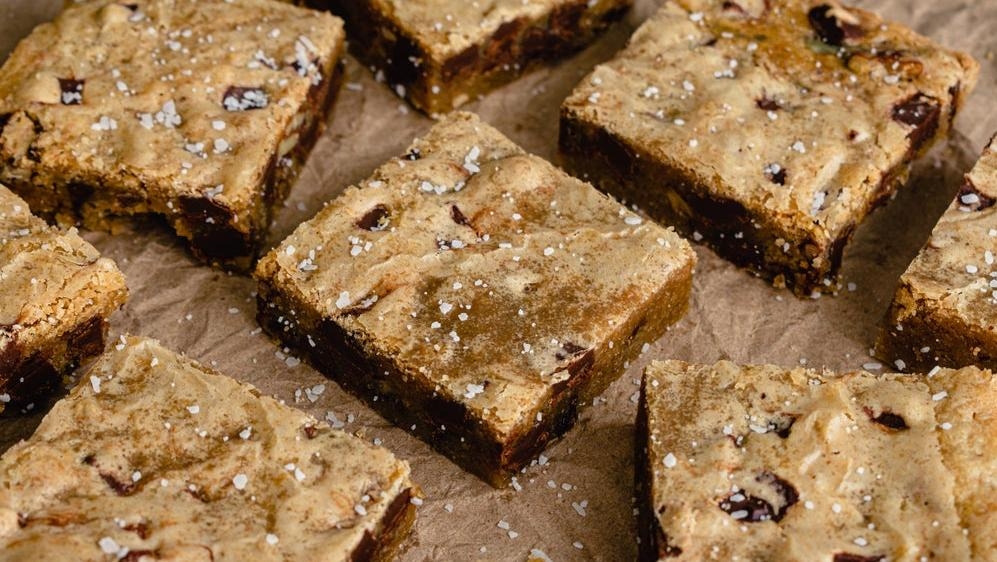Why Boozy Baked Goods Won't Get You (Or Your Kids) Drunk
How much alcohol gets baked out of our Butterscotch Bourbon Blondies anyway?
If you want a compelling argument for the transformative power of booze in desserts, let me direct you to Duff Goldman's recipe for Butterscotch-Bourbon Blondies. I've always found butterscotch too flatly sweet on its own, and blondies are just about the dullest dessert I can possibly imagine. Add 1/4 cup of bourbon, however, and the booze somehow ties everything together, creating an inviting dessert that's greater than the sum of its parts. But for those who plan on showing up to holiday gatherings with a batch of these blondies—or any other boozy dessert—does the alcohol render these sweets off-limits to the children in attendance? How much should we worry about the alcohol content of our baked goods?
What alcohol adds to desserts
You might be wondering why we add booze to desserts in the first place, if not to get sloshed. Alcohol serves a range of functions, depending on the recipe. In frozen treats like sorbet, for example, incorporating spirits enhances the overall smoothness, since it inhibits freezing and reduces the amount of water forming ice crystals within the mixture. In pie crust, the inclusion of alcohol is similarly scientific: Vodka provides the necessary moisture to make dough pliable, whereas using 100% water as the liquid triggers the formation of gluten and tends to create a sticky, unworkable dough.
In some cases, it just plain tastes good. In Butterscotch Bourbon Blondies, the titular booze provides a depth of flavor that can't be achieved with butterscotch and brown sugar alone, and when left to cure for a day, the bars actually have something akin to a warmth in each bite—the same warmth you feel when you sip on a glass of whiskey. Which brings us to a myth that must be dispelled.
“All the alcohol bakes off” is a myth
I was always told that cooking with wine and spirits is nothing to be concerned about, since the alcohol content bakes off as the liquid evaporates during the cooking (or baking) process. To some extent, that's true—but it doesn't bring the ABV of your dish down to zero.
The USDA has an extensive chart of Nutrient Retention Factors, which lists how much alcohol remains in food after a certain amount of cooking time. According to that chart, you'd have to simmer or bake the alcohol for 2.5 hours to bring the alcohol content down to 5% of its original total. After a more typical bake time of 30 minutes, 35% of the alcohol you started with is still in the resulting dish. And as Idaho State University dietician Barbara Gordon notes, bake time isn't the only part of the cooking process that can promote or inhibit the evaporation of alcohol.
"More alcohol remains in recipes made in smaller pans," Gordon writes. "A larger pot has more surface area which lets more of the alcohol evaporate. In addition, recipes that require you to stir during the cooking process, tend to have lower amounts of alcohol because this action also promotes evaporation."
And sometimes the booze added to a dish isn't cooked at all—for example, a fruitcake soaked in brandy after baking. This retains much more of the booze content, 70-80%.
Should we worry about the booze in our desserts?
Here's a reasonable question: When's the last time you heard of a four-year-old getting drunk off the sweets table?
"I don't know of any cases of kids getting inebriated from desserts with alcohol," Subha R. Das, Associate Professor of Chemistry at Carnegie Mellon University, tells The Takeout. "Overall these are not really consumed in quantities that would cause inebriation."
The only exception Das points to is if "you are feeding a baby that has relatively small body mass and large amounts of said dessert." Most kids only start taking solid foods when they're bigger, meaning they'd have to consume proportionally more of these baked goods to feel the effects—and that's an unlikely scenario.
"Ultimately inebriation depends on the dose, and there's not enough alcohol in a dessert that would lead to an effect," Das says. That certainly makes sense with something like my Bourbon Blondies, whose 1/4 cup of bourbon is initially baked off (partially), then distributed across a pan of 25 servings. That's .02 shots of alcohol per bar. If you ate a whole pan of them to get the effects of the entire half-shot of bourbon remaining in the batch, you'll encounter gastrointestinal issues, not inebriation issues.
And in the event that you're serving something really, really boozy, like an aged rum-soaked spice cake, adults probably aren't serving up heaping helpings to all the children at the party anyway. Not to mention that alcohol is, by and large, its own natural child repellant.
"When there is a large amount or higher concentration of alcohol, the smell and taste typically puts off kids from consuming a lot," he adds. (After all, it's a flavor and scent associated primarily with cough syrup to young kids!)
So, if you're worried about the little ones at your party, you can bake most items with those shots of booze and not have to worry. Sometimes, though, your guests live a sober lifestyle, whether for reasons related to health or religion or anything else, and in those cases forgoing this "secret" ingredient is the most polite and respectful thing to do. There are plenty of desserts that don't need alcohol to taste their best, and you're better off opting for those when you're not fully aware of someone's dietary restrictions. Good cheer doesn't always have to be 80 proof.
